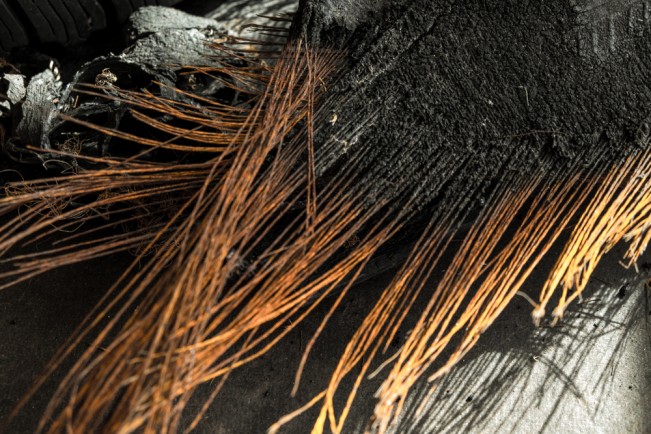Nanette Freeman: Diversion
The arts are as much about creative expression as they are about creating a second language for us to use to express pain, loss, trauma, and even joy. I met Nanette Rae Freeman at the Filter Photo Festival, and she shared a powerful body of work with me. Her project, Diversion, stems from a personal tragedy–losing her husband of 25 years in a violent motorcycle accident. After the accident, she found herself drawn to blown out tires seen along the road, thinking of them as parts of a whole, as layers and fragments that are metaphors for a life torn apart. As an artist, she has been compelled to amass the shredded rubber and give it new considerations.
Nanette Rae Freeman was a librarian at The Chicago Public Library for 23 years serving community members in neighborhoods throughout Chicago. She attributes her obsession for working with diverse populations to her childhood spent accompanying her father who owned, operated and repaired pinball machines, jukeboxes and vending machines in bowling alleys, funky businesses in garages, and taverns throughout Chicago.
Nanette is sure her husband, Fred Dech, would be amused to see her working with blown out tires as a photographic material as it echoes their shared longing for the unusual, which they pursued throughout their lives together.
My husband was killed on July 18, 2011, on a motorcycle speeding down the Dan Ryan Expressway on his way to work. In the wake of this unfathomable loss, I began to find fascination in the remains of blown out tires on the expressway. One day the violent energy of a blowout jolted me to the point that I felt compelled to stop and retrieve it. I finally had something tangible that evoked feelings of trauma, violence, and even death. I found a surprising comfort in the physicality of the mangled tire. It connected me to my husband, Fred, whose body and mind I lost in this harrowing accident.
For this body of work, I’ve been employing found blown-out tire shreds to document them as a photographic material. I photograph them in a way that exemplifies their physical features which helps me interpret and transform them. The rendering of rich textures aims to inspire memories of skin, hair, and other humanizing elements– elements torn and obliterated from their former shape, which is very much like the relationship I now share with my husband.
Posts on Lenscratch may not be reproduced without the permission of the Lenscratch staff and the photographer.
Recommended
-
Sunjoo Lee: Untold
October 20th, 2025 -
Suzanne Theodora White in Conversation with Frazier KingSeptember 10th, 2025
-
2025 PPA Photo Award Winner: Teela Misa DeLeónSeptember 5th, 2025
-
The 2025 Lenscratch Honorable Mention Winner: Montenez LoweryJuly 26th, 2025
-
LUMINOUS VISIONS: Shoshannah WhiteJuly 17th, 2025





























































